Rate-Dependent Cohesive Zone Model for Fracture Simulation of Soda-Lime Glass Plate
Abstract
:1. Introduction
2. Rate-Dependent Cohesive Zone Model
2.1. Traction–separation Law
2.2. Mixed-Mode Failure
3. Simulation Results and Experimental Validation
3.1. Set Up of Experimental Test
3.2. Finite Element Model
3.3. Result Analysis
3.3.1. Elastic Result
3.3.2. Rate-Dependent CZM Results
4. Parametric Studies
4.1. Strain Rate Sensitivity Coefficient C
4.2. Mesh Size
4.3. Impact Velocity
5. Conclusions
- (1)
- Soda-lime glass is a rate dependent material. It is necessary to consider the rate dependence of glass when simulating fracture under impact loading. The numerical simulation results show that the rate-dependent CZM considering the strain rate is more accurate.
- (2)
- The rate-dependent CZM is applied to the finite element simulation by VUMAT. In the rate-dependent CZM, the maximum traction and the maximum separation are rate dependent, which results in that the cohesive element dissipate more energy when it is damaged. The strain rate effect forms a shielding zone in the region with high strain rate, which makes the energy propagate outward.
- (3)
- The rate-dependent cohesive zone model has little dependence on the mesh size. Furthermore, more kinetic energy is needed to form a circular crack compared with a radial crack.
Author Contributions
Funding
Conflicts of Interest
References
- Minor, J.E. Lessons Learned from Failures of the Building Envelope in Windstorms. J. Archit. Eng. 2005, 11, 10–13. [Google Scholar] [CrossRef]
- Nie, X.; Chen, W.W.; Sun, X.; Templeton, D.W. Dynamic Failure of Borosilicate Glass Under Compression/Shear Loading Experiments. J. Am. Ceram. Soc. 2007, 90, 2556–2562. [Google Scholar] [CrossRef]
- Nie, X.; Chen, W. High-Rate Progressive Failure of Borosilicate Glass under Mechanical Confinement at High Temperatures. Exp. Mech. 2013, 53, 67–75. [Google Scholar] [CrossRef]
- Nie, X.; Chen, W.W. Dynamic Equibiaxial Flexural Strength of Borosilicate Glass at High Temperatures. Exp. Mech. 2012, 52, 135–143. [Google Scholar] [CrossRef]
- Sun, X.; Liu, W.; Chen, W.; Templeton, D. Modeling and characterization of dynamic failure of borosilicate glass under compression/shear loading. Int. J. Impact. Eng. 2009, 36, 226–234. [Google Scholar] [CrossRef]
- Daryadel, S.S.; Mantena, P.R.; Kim, K.; Stoddard, D.; Rajendran, A.M. Dynamic response of glass under low-velocity impact and high strain-rate SHPB compression loading. J. Non Cryst. Solids 2016, 432, 432–439. [Google Scholar] [CrossRef]
- Holmquist, T.J.; Johnson, G.R.; Lopatin, C.M.; Grandy, D.E. High strain rate properties and constitutive modeling of glass. In Proceedings of the 15th International Symposium on Ballistics, Jerusalem, Israel, 21–24 May 1995; pp. 237–244. [Google Scholar]
- Peroni, M.; Solomos, G.; Pizzinato, V.; Larcher, M. Experimental Investigation of High Strain-Rate Behaviour of Glass. Appl. Mech. Mater. 2011, 68, 63–68. [Google Scholar] [CrossRef]
- Zhang, X.; Zou, Y.; Hao, H.; Li, X.; Ma, G.; Liu, K. Laboratory Test on Dynamic Material Properties of Annealed Float Glass. Int. J. Prot. Struct. 2012, 3, 407–430. [Google Scholar] [CrossRef]
- Zhang, X.; Hao, H.; Ma, G. Dynamic material model of annealed soda-lime glass. Int. J. Impact Eng. 2015, 77, 108–119. [Google Scholar] [CrossRef] [Green Version]
- Zhang, X.; Hao, H.; Ma, G. Laboratory test and numerical simulation of laminated glass window vulnerability to debris impact. Int. J. Impact Eng. 2013, 55, 49–62. [Google Scholar] [CrossRef]
- Overend, M.; Parke, G.A.; Buhagiar, D. Predicting Failure in Glass-A General Crack Growth Model. J. Struct. Eng. 2007, 133, 1146–1155. [Google Scholar] [CrossRef] [Green Version]
- Zhou, F.; Molinari, J.; Ramesh, K.T. Characteristic fragment size distributions in dynamic fragmentation. Appl. Phys. Lett. 2006, 88, 261918. [Google Scholar] [CrossRef]
- Dharani, L.R.; Ji, F.; Behr, R.A.; Minor, J.E.; Kremer, P.A. Breakage Prediction of Laminated Glass Using the "Sacrificial Ply" Design Concept. J. Archit. Eng. 2004, 10, 126–135. [Google Scholar] [CrossRef]
- Ji, F.S.; Dharani, L.R.; Behr, R.A. Damage probability in laminated glass subjected to low velocity small missile impacts. J. Mater. Sci. 1998, 33, 4775–4782. [Google Scholar] [CrossRef]
- Nurhuda, I.; Lam, N.T.K.; Gad, E.F.; Calderone, I. Estimation of strengths in large annealed glass panels. Int. J. Solids Struct. 2010, 47, 2591–2599. [Google Scholar] [CrossRef] [Green Version]
- Pyttel, T.; Liebertz, H.; Cai, J. Failure criterion for laminated glass under impact loading and its application in finite element simulation. Int. J. Impact Eng. 2011, 38, 252–263. [Google Scholar] [CrossRef]
- Xu, X.Q.; Liu, B.H.; Wang, Y.; Li, Y.B.; Xu, J. A numerical model on PVB laminated windshield subjected to headform low-speed impact. J. Phys. Conf. Ser. 2013, 451, 12016. [Google Scholar] [CrossRef] [Green Version]
- Zhang, X.; Hao, H.; Ma, G. Parametric study of laminated glass window response to blast loads. Eng. Struct. 2013, 56, 1707–1717. [Google Scholar] [CrossRef]
- Peng, Y.; Yang, J.; Deck, C.; Willinger, R. Finite element modeling of crash test behavior for windshield laminated glass. Int. J. Impact Eng. 2013, 57, 27–35. [Google Scholar] [CrossRef]
- Hidallana-Gamage, H.D.; Thambiratnam, D.P.; Perera, N.J. Numerical modelling and analysis of the blast performance of laminated glass panels and the influence of material parameters. Eng. Fail. Anal. 2014, 45, 65–84. [Google Scholar] [CrossRef]
- Liu, B.; Xu, T.; Xu, X.; Wang, Y.; Sun, Y.; Li, Y. Energy absorption mechanism of polyvinyl butyral laminated windshield subjected to head impact: Experiment and numerical simulations. Int. J. Impact Eng. 2016, 90, 26–36. [Google Scholar] [CrossRef]
- Jaśkowiec, J. Numerical Modeling Mechanical Delamination in Laminated Glass by XFEM. Procedia Eng. 2015, 108, 293–300. [Google Scholar] [CrossRef]
- Xu, J.; Li, Y.; Chen, X.; Yan, Y.; Ge, D.; Zhu, M.; Liu, B. Characteristics of windshield cracking upon low-speed impact: Numerical simulation based on the extended finite element method. Comp. Mater. Sci. 2010, 48, 582–588. [Google Scholar] [CrossRef]
- Xu, X.; Xu, J.; Chen, J.; Li, P.; Liu, B.; Li, Y. Investigation of dynamic multi-cracking behavior in PVB laminated glass plates. Int. J. Impact Eng. 2017, 100, 62–74. [Google Scholar] [CrossRef]
- Ghaffari, D.; Rash Ahmadi, S.; Shabani, F. XFEM simulation of a quenched cracked glass plate with moving convective boundaries. C. R. Mécanique 2016, 344, 78–94. [Google Scholar] [CrossRef]
- Xu, X.P.; Needleman, A. Void nucleation by inclusion debonding in a crystal matrix. Model. Simul. Mater. Sci. Eng. 1993, 1, 111–132. [Google Scholar] [CrossRef]
- Repetto, E.A.; Radovitzky, R.; Ortiz, M. Finite element simulation of dynamic fracture and fragmentation of glass rods. Comput. Methods Appl Mech. Eng. 2000, 183, 3–14. [Google Scholar] [CrossRef]
- Camanho, P.P.; Davila, C.G.; de Moura, M.F. Numerical Simulation of Mixed-Mode Progressive Delamination in Composite Materials. J. Compos. Mater. 2003, 37, 1415–1438. [Google Scholar] [CrossRef]
- Gao, W.; Xiang, J.; Chen, S.; Yin, S.; Zang, M.; Zheng, X. Intrinsic cohesive modeling of impact fracture behavior of laminated glass. Mater. Design 2017, 127, 321–335. [Google Scholar] [CrossRef]
- Barenblatt, G.I. The Mathematical Theory of Equilibrium Cracks in Brittle Fracture. Adv. Appl. Mech. 1962, 7, 32. [Google Scholar] [CrossRef]
- Dugdale, D.S. Yielding of steel sheets containing slits. J. Mech. Phys. Solids 1960, 8, 100–104. [Google Scholar] [CrossRef]
- Celes, W.; Paulino, G.H.; Espinha, R. A compact adjacency-based topological data structure for finite element mesh representation. Int. J. Numer. Meth. Eng. 2005, 64, 1529–1556. [Google Scholar] [CrossRef]
- Zhang, Z.J.; Paulino, G.H.; Celes, W. Extrinsic cohesive modelling of dynamic fracture and microbranching instability in brittle materials. Int. J. Numer. Meth. Eng. 2007, 72, 893–923. [Google Scholar] [CrossRef]
- Chen, S.; Zang, M.; Xu, W. A three-dimensional computational framework for impact fracture analysis of automotive laminated glass. Comput. Methods Appl. Mech. Eng. 2015, 294, 72–99. [Google Scholar] [CrossRef]
- Chen, S.; Zang, M.; Wang, D.; Zheng, Z.; Zhao, C. Finite element modelling of impact damage in polyvinyl butyral laminated glass. Compos. Struct. 2016, 138, 1–11. [Google Scholar] [CrossRef]
- Lin, D.; Wang, D.; Chen, S.; Zang, M. Numerical simulations of impact fracture behavior of an automotive windshield glazing: An intrinsic cohesive approach. Compos. Struct. 2018, 186, 79–93. [Google Scholar] [CrossRef]
- Musto, M.; Alfano, G. A fractional rate-dependent cohesive-zone model. Int. J. Numer. Meth. Eng. 2015, 103, 313–341. [Google Scholar] [CrossRef] [Green Version]
- André, D.; Jebahi, M.; Iordanoff, I.; Charles, J.; Néauport, J. Using the discrete element method to simulate brittle fracture in the indentation of a silica glass with a blunt indenter. Comput. Methods Appl. Mech. Eng. 2013, 265, 136–147. [Google Scholar] [CrossRef] [Green Version]
- Braun, M.; Fernández-Sáez, J. A new 2D discrete model applied to dynamic crack propagation in brittle materials. Int. J. Solids Struct. 2014, 51, 3787–3797. [Google Scholar] [CrossRef] [Green Version]
- Du Bois, P.A.; Kolling, S.; Fassnacht, W. Modelling of safety glass for crash simulation. Comp. Mater. Sci. 2003, 28, 675–683. [Google Scholar] [CrossRef]
- Timmel, M.; Kolling, S.; Osterrieder, P.; Du Bois, P.A. A finite element model for impact simulation with laminated glass. Int. J. Impact Eng. 2007, 34, 1465–1478. [Google Scholar] [CrossRef]
- Yao, J.; Yang, J.; Otte, D. Investigation of head injuries by reconstructions of real-world vehicle-versus-adult-pedestrian accidents. Safety Sci. 2008, 46, 1103–1114. [Google Scholar] [CrossRef]
- Xu, X.P.; Needleman, A. Numerical simulations of fast crack growth in brittle solids. J. Mech. Phys. Solids 1994, 42, 1397–1434. [Google Scholar] [CrossRef]
- Benzeggagh, M.L.; Kenane, M. Measurement of mixed-mode delamination fracture toughness of unidirectional glass/epoxy composites with mixed-mode bending apparatus. Compos. Sci. Technol. 1996, 56, 439–449. [Google Scholar] [CrossRef]
- De Pauw, S. Experimental and Numerical Study of Impact on Window Glass Fitted with Safety Window Film. Ph.D. Thesis, Ghent University, Ghent, Belgium, 2010. [Google Scholar]
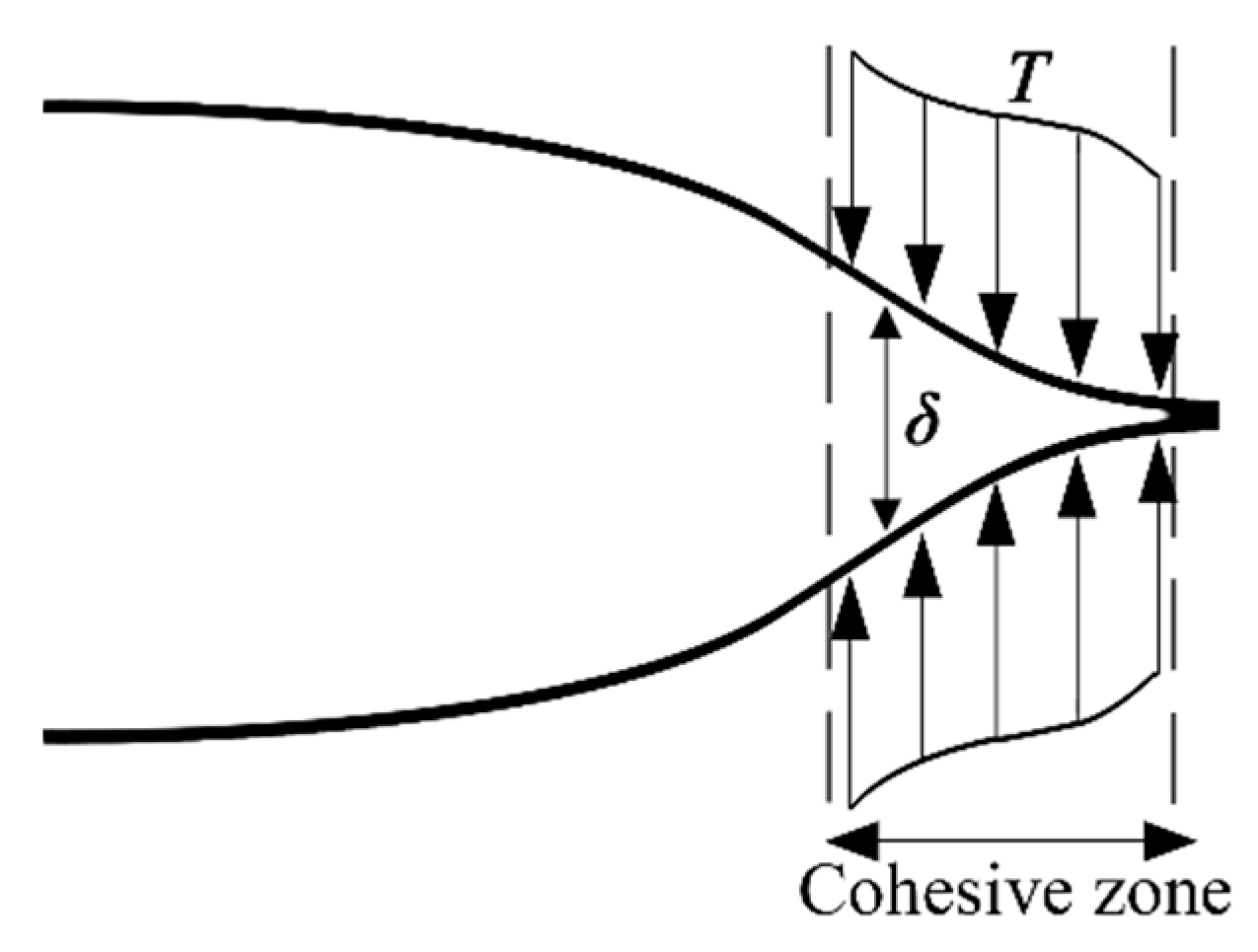
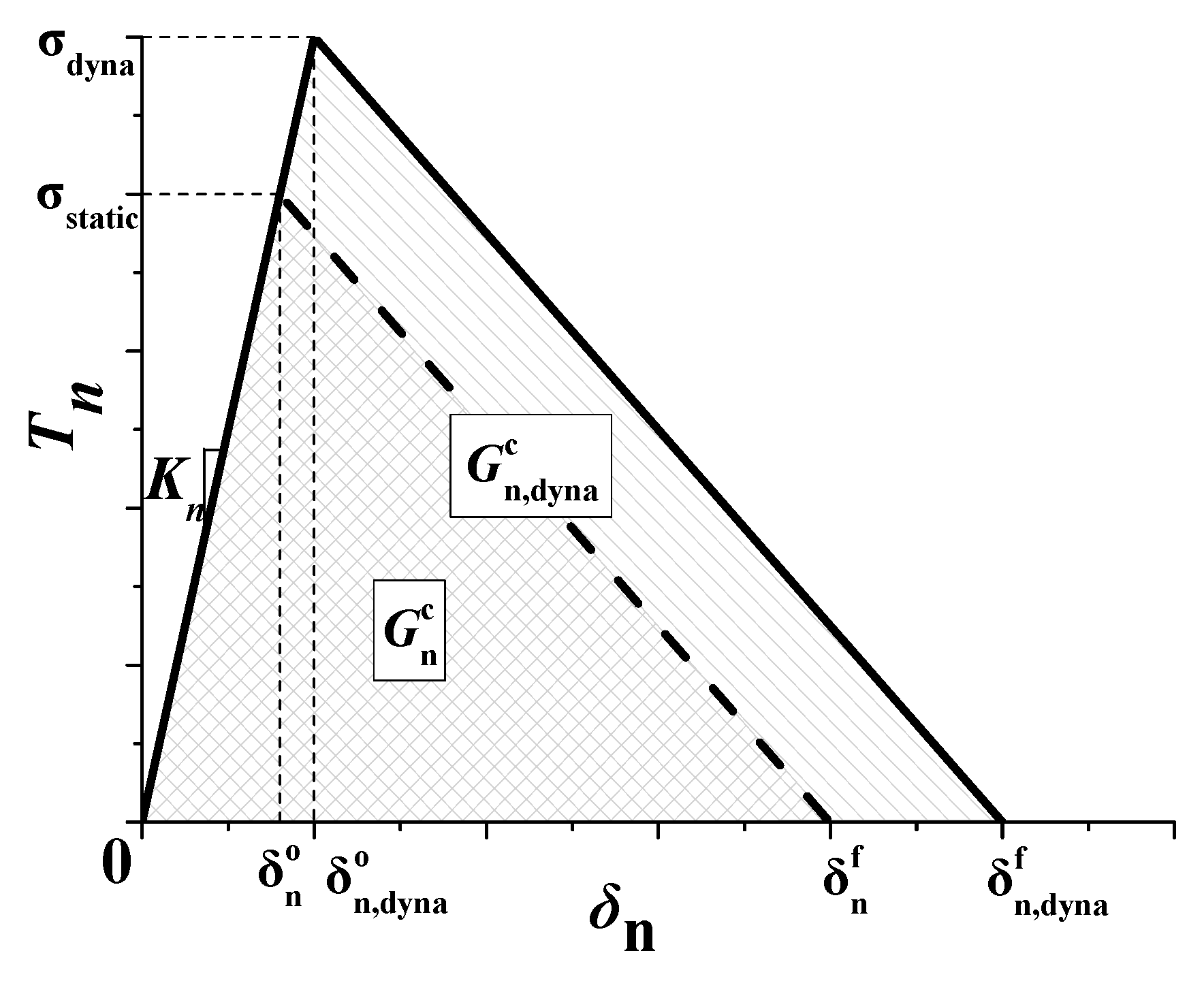
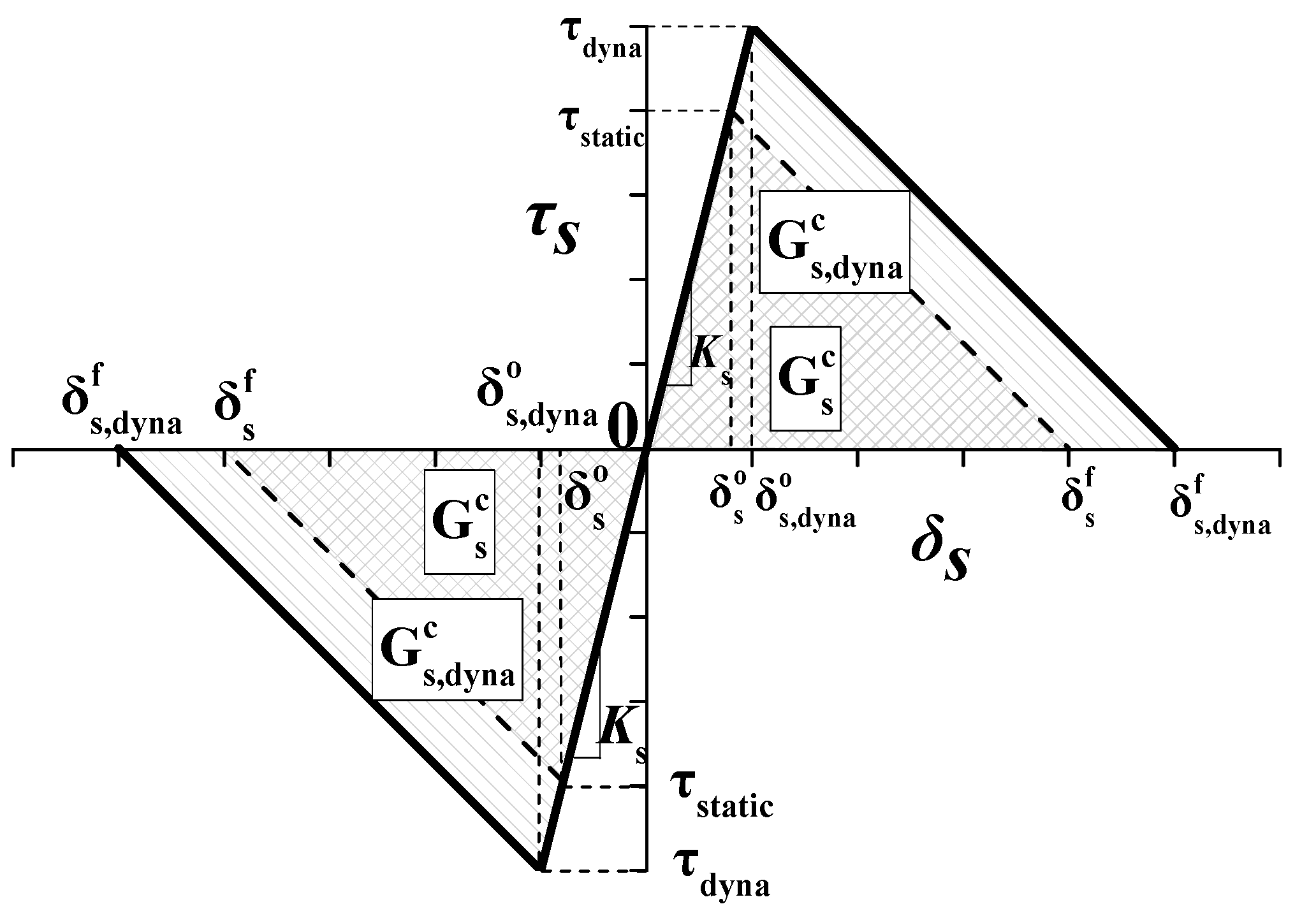

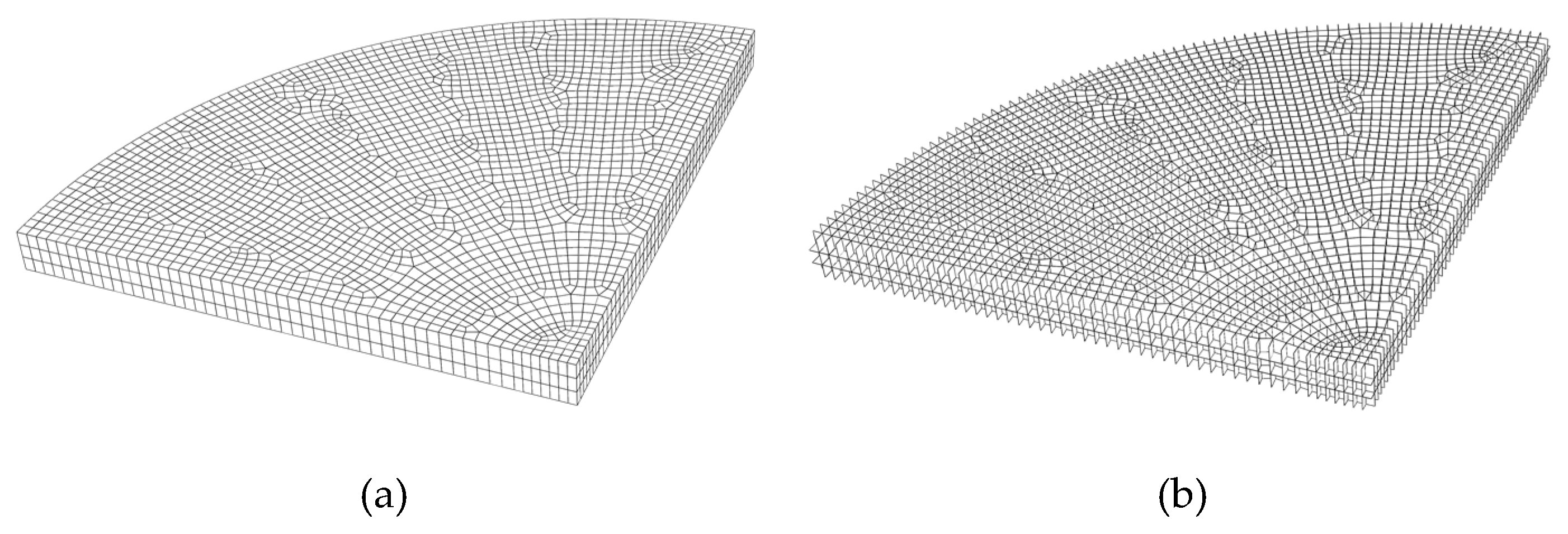
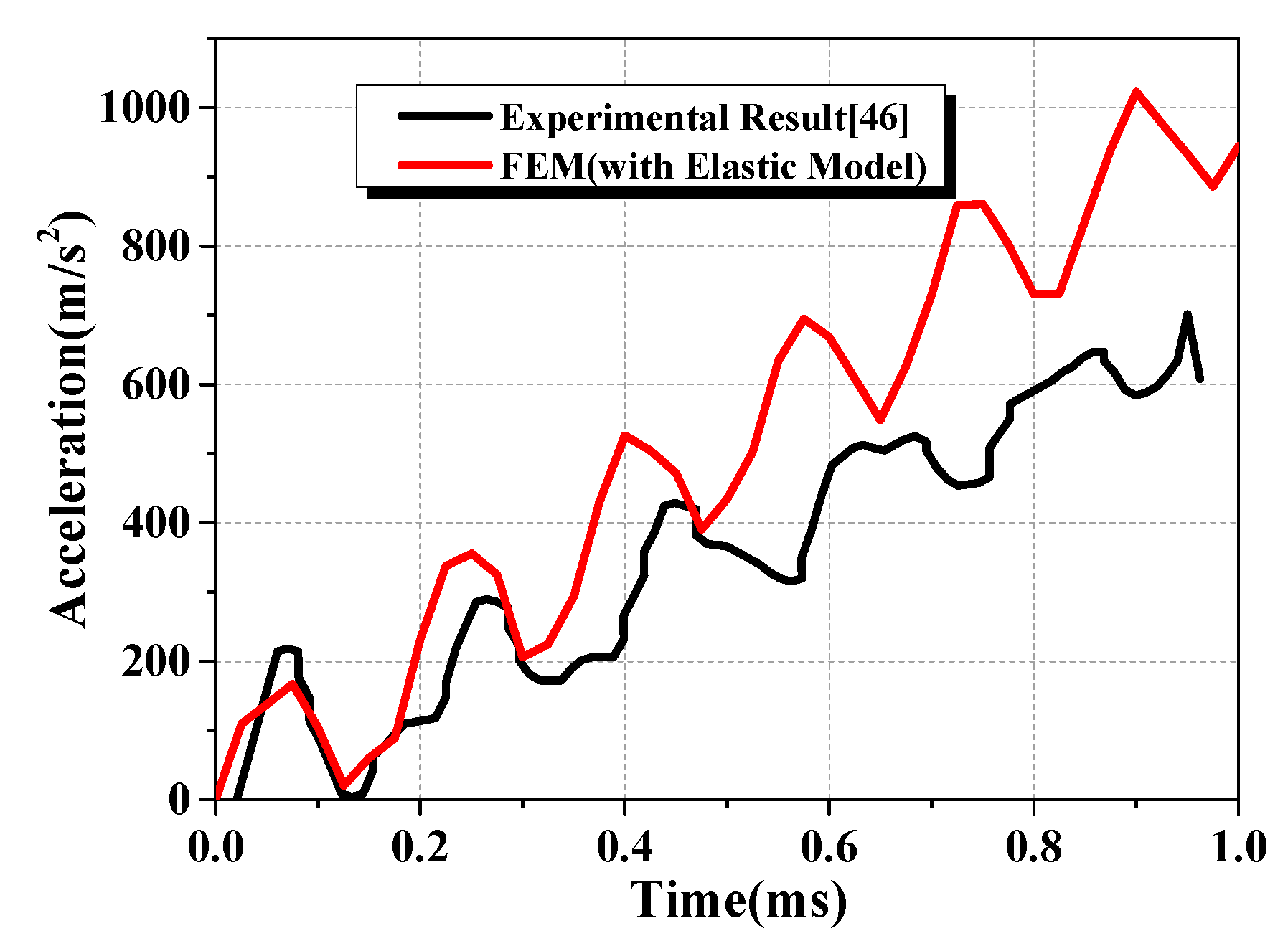

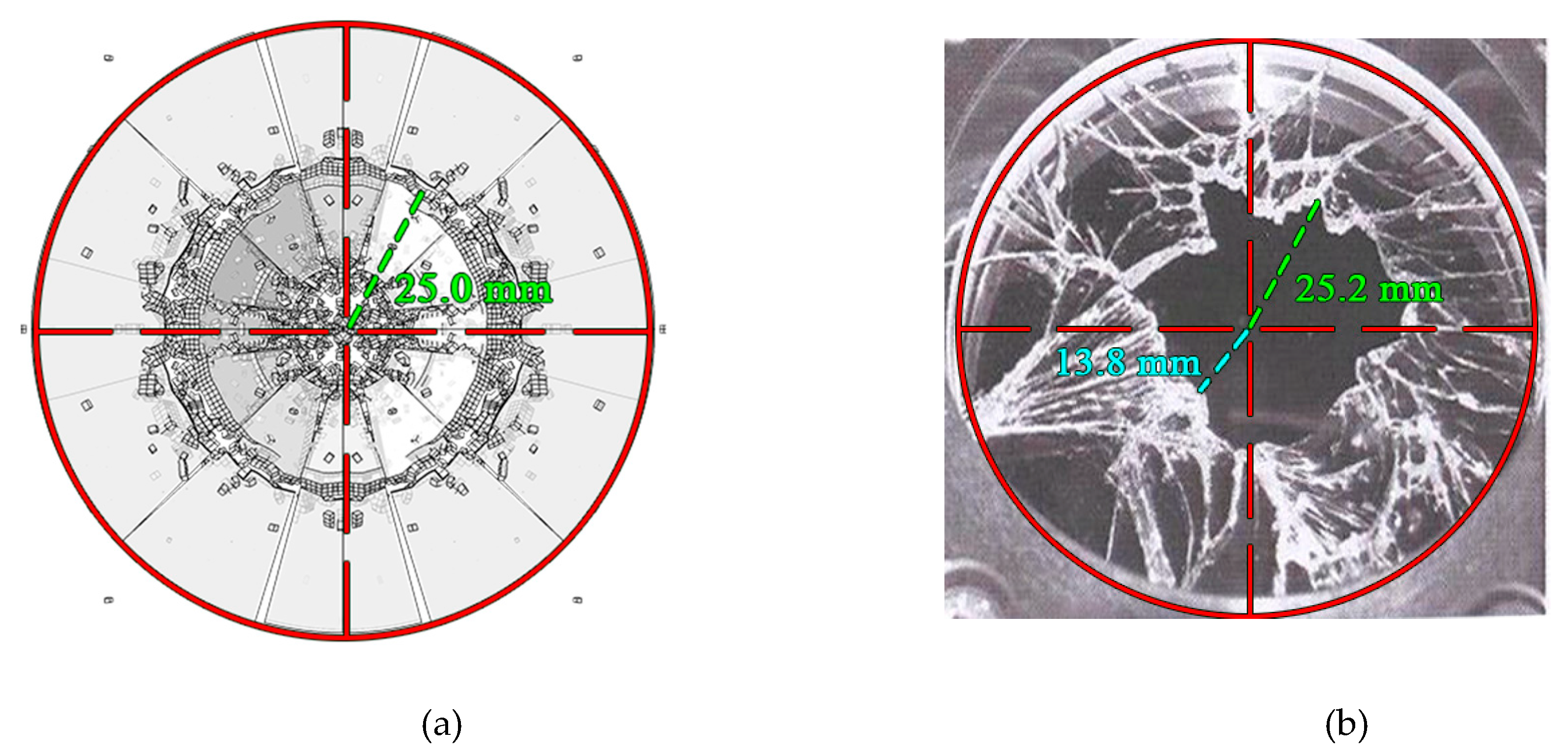

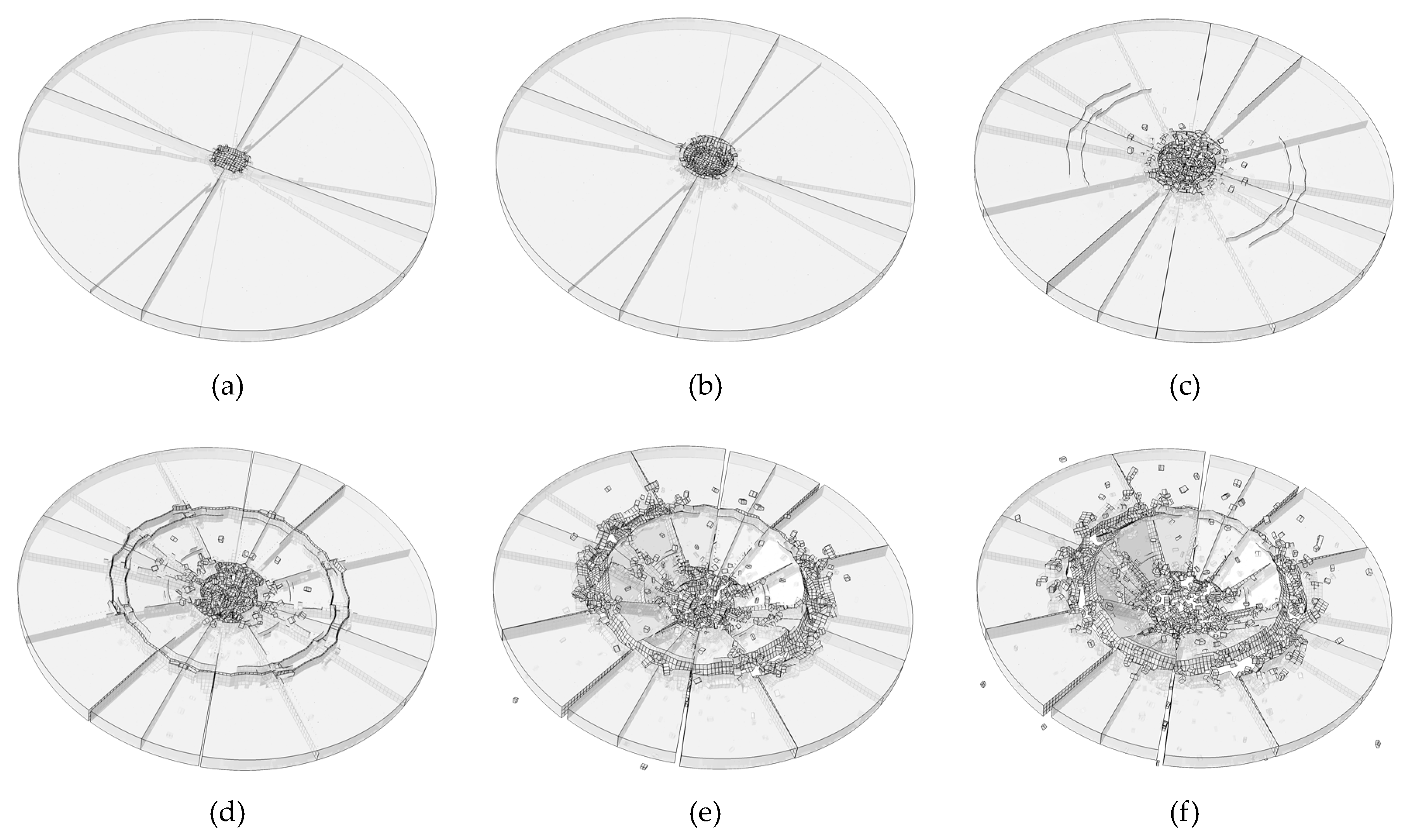
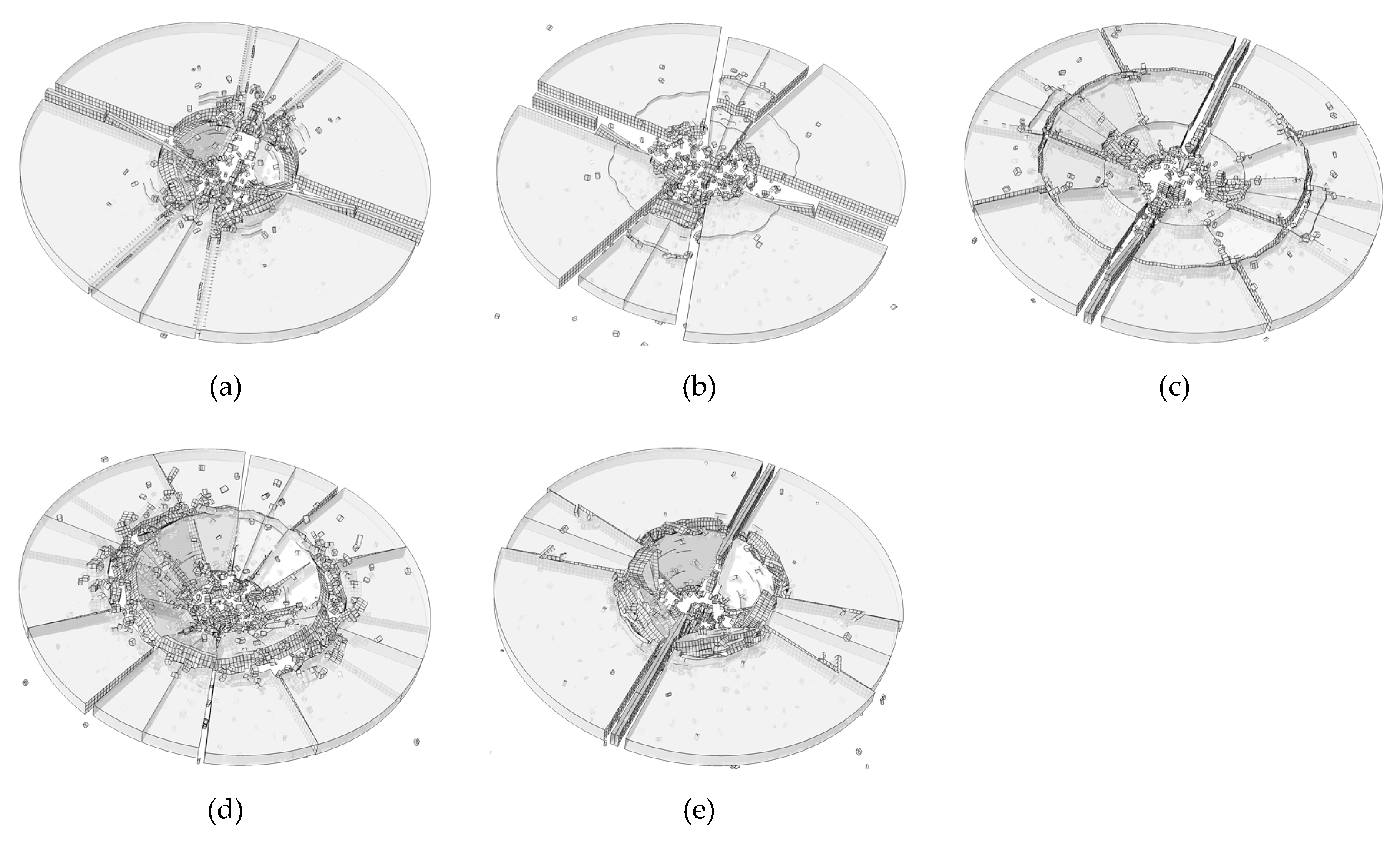


| Mesh Size of Impactor (mm) | Kinetic Energy (mJ) | Error (%) |
|---|---|---|
| 1 | 13382.3 | 0.19 |
| 2 | 13277.1 | 0.97 |
| 3 | 12922.2 | 3.62 |
| 4 | 12864.9 | 4.05 |
| Material | Density (kg/m3) | Young’s Modulus (GPa) | Poisson’s Ratio |
|---|---|---|---|
| Soda-lime glass | 2530 | 73 | 0.3 |
| Polypropylene | 1000 | 2 | 0.3 |
© 2020 by the authors. Licensee MDPI, Basel, Switzerland. This article is an open access article distributed under the terms and conditions of the Creative Commons Attribution (CC BY) license (http://creativecommons.org/licenses/by/4.0/).
Share and Cite
Li, D.; Wei, D. Rate-Dependent Cohesive Zone Model for Fracture Simulation of Soda-Lime Glass Plate. Materials 2020, 13, 749. https://doi.org/10.3390/ma13030749
Li D, Wei D. Rate-Dependent Cohesive Zone Model for Fracture Simulation of Soda-Lime Glass Plate. Materials. 2020; 13(3):749. https://doi.org/10.3390/ma13030749
Chicago/Turabian StyleLi, Dong, and Demin Wei. 2020. "Rate-Dependent Cohesive Zone Model for Fracture Simulation of Soda-Lime Glass Plate" Materials 13, no. 3: 749. https://doi.org/10.3390/ma13030749




